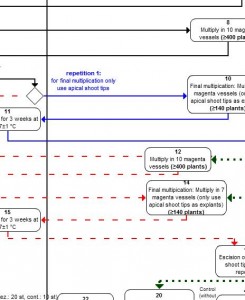- Where do new mushrooms come from? Hint: domestication of wild species has not stopped.
- And resistance to fireblight in apples? Hint: a single specimen of an old variety.
- How about help for flood-stricken Nigerian farmers? Hint: a gene bank!
- Where do people get gender in agriculture all wrong? Hint: women may bring home the bacon, but if that threatens their husband’s status, rationality flies out the door.
- Where, from 10-13 December, can you learn about “Crops from the past and new crops in adressing (sic) the challenges of the XXI century”? Hint: Córdoba, Spain.
- Where did the Dust Bowl go? Hint: it never went away.
- Where to get the straight dope on System of Rice Intensification? Hint: an SRI researcher may not be unbiased.
- Where are government and civil society elaborating a National Plan for Agroecology and Organic Production? Hint: a river runs through it.
Brainfood: Pig genome, Turkey genome, Big genomes, Maize genome, Potato improvement, Mango diversity, Coconut germination
- Analyses of pig genomes provide insight into porcine demography and evolution. More wild diversity in Asia, suggesting origin there, followed by migration to Europe. Separate domestication in SE Asia and Europe, followed by geneflow.
- Whole genome SNP discovery and analysis of genetic diversity in Turkey (Meleagris gallopavo). Lot less diverse than chicken. Or pig. Commercial breed even less diverse.
- Why size really matters when sequencing plant genomes. We must not shy away from the big genomes.
- QTL mapping in three tropical maize populations reveals a set of constitutive and adaptive genomic regions for drought tolerance. Eureka!
- Crops that feed the world 8: Potato: are the trends of increased global production sustainable? Maybe. But can you guess what will be needed? Nice review of genebank holdings and improvement strategies and aims.
- Physico-chemical Characterization of Unexploited Mango Diversity in Sub-mountane Zone of Northern India. 28 varieties in the Punjab, with all kinds of different uses.
- Germination Rate is the Significant Characteristic Determining Coconut Palm Diversity. Natural and artificial selection associated with different rates of germination (as well as other phenotypic traits of course).
It’s germplasm evaluation, Jim, but not as we know it
Next generation sequencing (NGS) holds the promise for a more efficient approach to germplasm evaluation whereby a carefully selected subset of accessions can be sequenced and phenotyped in detail; associations discovered between genotypes and phenotypes in this subset could be used to predict the phenotype of other accessions based on sequence data alone.
Ah, “the promise.” Always the promise. But actually, in this document, “Technical appraisal of strategic approaches to large-scale germplasm evaluation,” some of the practicalities are spelled out, and in quite a lot of detail. You be the judge of whether the vision outlined in that opening quote is of a far-away, Star Trek world, or something that’s really just around the next corner. You can comment on the document itself, or here if you prefer.
Nibbles: Polymotu, Korean genebank, Arizona fruits, B4N, Rice song, Medieval food
- A “grand, almost surreal vision” of coconut conservation.
- A grandish vision of ex situ crop conservation in Korea.
- A very down-to-earth vision of fruit conservation in Arizona.
- An extremely wacky vision of the post-agricultural world.
- A workmanlike vision of biodiversity for nutrition project.
- A musical vision of rice husking.
- A historical vision of food in the Middle Ages.
ISO certification: What is it good for?
 Do genebanks need ISO certification to maintain standards? Or accreditation. Or whatever. We have talked about the issue of quality assurance here in the past. But a random Facebook status update of mine on the subject recently elicited a stronger reaction than I had seen in a while. What do you think? Comment here, or on Facebook. We’ll figure out a way of bringing it all together if there’s a good response.
Do genebanks need ISO certification to maintain standards? Or accreditation. Or whatever. We have talked about the issue of quality assurance here in the past. But a random Facebook status update of mine on the subject recently elicited a stronger reaction than I had seen in a while. What do you think? Comment here, or on Facebook. We’ll figure out a way of bringing it all together if there’s a good response.